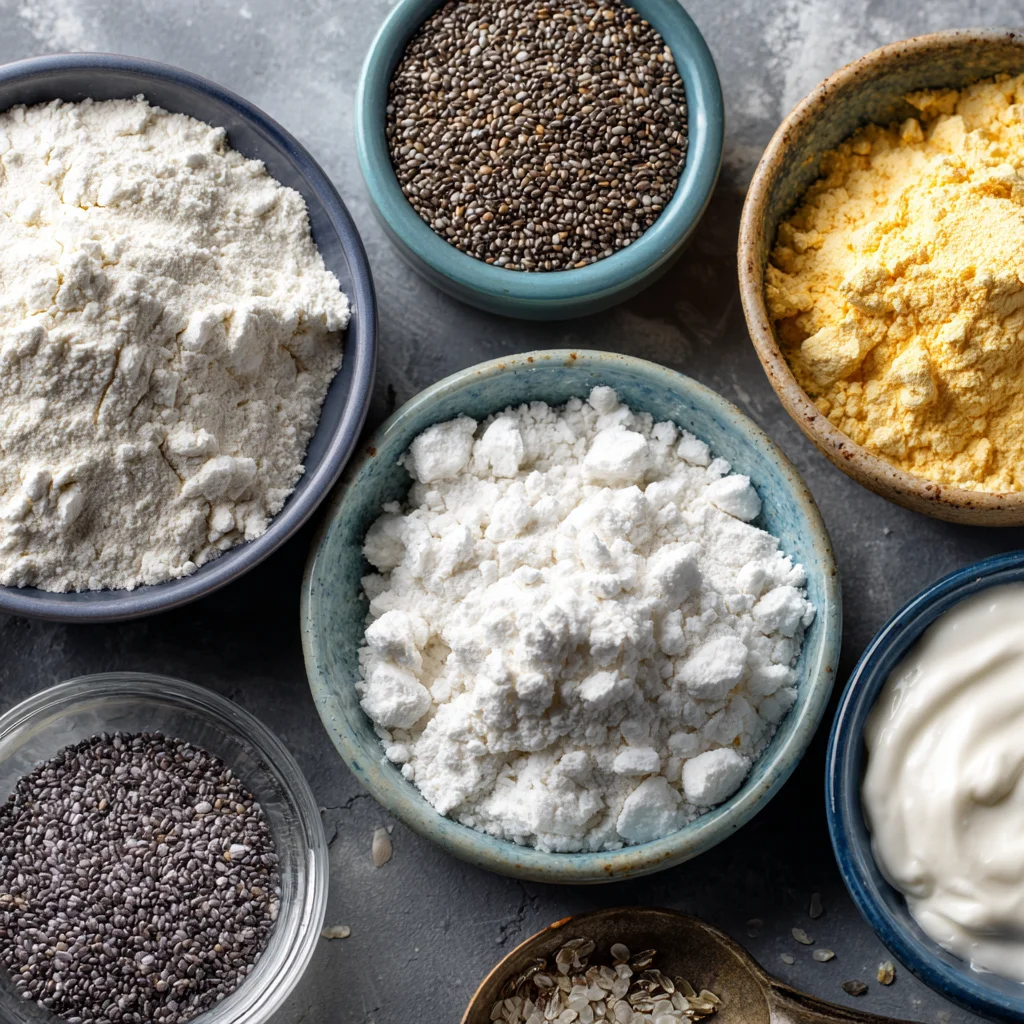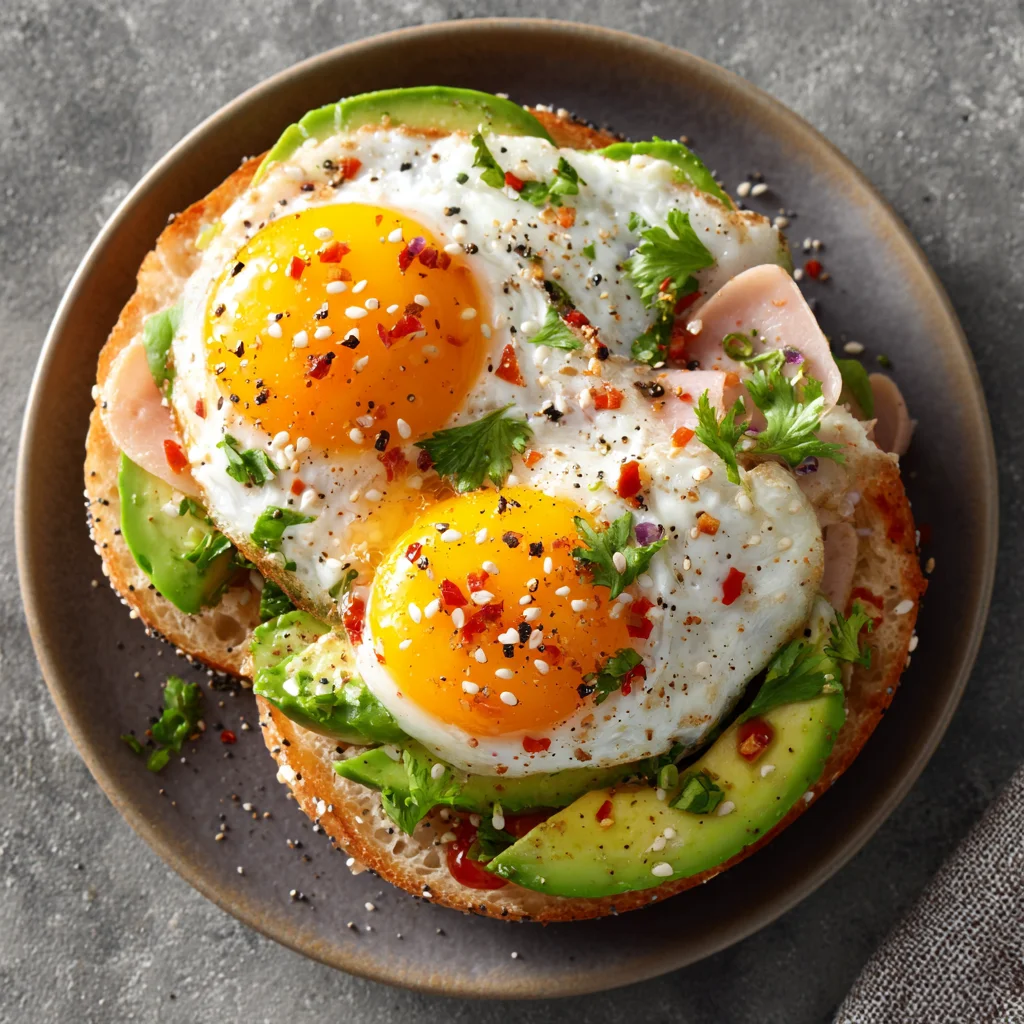Looking to start your morning strong with something delicious and nutrient-dense? A high protein bagel is the ultimate fusion of flavor and function—crunchy on the outside, soft on the inside, and loaded with ingredients that power your day. Whether you’re after post-workout fuel, meal prep solutions, or simply a satisfying breakfast that keeps you full longer, this guide breaks it all down.
In this article, we’ll explore the best high protein bagel recipe you can make at home, the science behind what makes it protein-rich, and tips to enhance its nutrition and taste. You’ll also find topping ideas, comparisons with store-bought options, and prep hacks that make healthy eating sustainable—even on your busiest days.
Don’t miss our Protein Cookie Dough Recipe—a perfect sweet complement to your high-protein morning routine.
Table of Contents
Table of Contents
Understanding the High Protein Bagel Trend
Why Are High Protein Bagels So Popular?
High protein bagels aren’t just a food fad—they’re a functional choice. As more people prioritize balanced macros, especially protein intake, traditional bagels are getting a healthy makeover. Following a good high protein bagel recipe, these bagels offer:
- A longer feeling of fullness (thanks to protein’s satiety)
- Better muscle support, especially when paired with a morning workout
- Blood sugar stability, which avoids the crash that comes from plain refined carbs
With wellness trends leaning heavily on meal prep, post-workout nutrition, and clean eating, it’s no wonder these bagels are dominating breakfast tables.
The Nutritional Power Behind Protein-Enriched Bagels
Protein-rich bagels can easily pack 12–25g of protein per serving, depending on what goes into them. Common enhancements include:
- High-protein flours like spelt, almond, or whole wheat
- Additions like Greek yogurt, eggs, and protein powder
- Seeds such as chia, flax, or hemp for both protein and omega-3s
Here’s a quick comparison table:
| Bagel Type | Protein (approx) | Key Ingredients |
|---|---|---|
| Regular White Bagel | 8g | White flour, sugar, water |
| High Protein Bagel | 16–25g | Whole grain flour, egg whites, whey |
| Vegan Protein Bagel | 15–20g | Lentil flour, pea protein, chia seeds |
High protein bagels don’t just support fitness goals—they taste better, digest slower, and offer sustained energy throughout the day.
What Makes a Bagel High in Protein?
Choosing the Right Ingredients: Flour, Seeds, and Protein Powders
Crafting a truly high protein bagel starts with swapping out the usual suspects for smarter, protein-rich options. Every effective high protein bagel recipe starts with the right foundation—protein-rich flour, yogurt, and seeds. Here’s what to focus on:
1. High-Protein Flours
Instead of regular all-purpose flour, these flour choices naturally boost protein content:
- Whole Wheat Flour – adds fiber and about 6g of protein per ¼ cup
- Almond Flour – grain-free and contains around 6g protein per ¼ cup
- Spelt or Quinoa Flour – high in protein and micronutrients
Mixing flours—like whole wheat with almond flour—can create the perfect balance between texture and nutrition.
2. Seeds for a Boost
Seeds bring more than just crunch—they’re a great source of plant-based protein and heart-healthy fats :
- Chia Seeds: 2g protein per tablespoon
- Flax Seeds: 1.3g protein per tablespoon
- Hemp Seeds: 3g protein per tablespoon
These also add fiber, omega-3s, and help create a dense, satisfying bite.
3. Protein Powders That Work Best
Incorporating protein powder can take your bagel from decent to exceptional in terms of macros:
- Whey Protein Isolate – ideal for non-vegans, blends smoothly into dough
- Pea Protein – a top choice for plant-based eaters
- Collagen Peptides – adds protein without altering flavor or texture
Pro Tip: Limit protein powder to 10–20% of the dry ingredient base to avoid drying out your dough.
Secret Add-Ins to Boost Protein Without Changing Taste
Not every ingredient needs to announce itself. These subtle mix-ins increase protein with minimal impact on flavor:
- Egg Whites – replace some of the water in your dough to increase structure and protein
- Greek Yogurt – adds creaminess and about 10g protein per 100g serving
- Cottage Cheese (blended) – a secret weapon for moist, fluffy bagels with an extra 12g of protein per ½ cup
Even small swaps like using nut-based milk over water or adding a spoon of nutritional yeast can make a difference in protein content.
Discover great ideas like our Savory Oatmeal Bowl—another powerful protein-packed breakfast option you’ll love.

Best Protein Sources for Homemade Bagels
Top Plant-Based Proteins for Bagels
Want to keep your bagels dairy-free and plant-powered? No problem. Here are some smart, protein-rich alternatives that work beautifully in homemade dough:
For those following a plant-based high protein bagel recipe, pea protein and lentil flour are unbeatable.
1. Pea Protein
Pea protein powder blends easily into dough and has a mellow taste. It offers about 10–15 grams of protein per two tablespoons, making it a powerful option for plant-based bakers.
2. Lentil Flour
This lesser-known flour packs in protein and works great as a partial flour substitute. With around 12g of protein per ¼ cup, it boosts both the nutrition and the earthiness of your bagel.
3. Hemp and Chia Seeds
Hemp seeds contribute valuable protein and omega fats. Add two tablespoons to your dough and you’ll sneak in roughly 5–6 grams of plant protein, plus a satisfying nutty crunch. Chia seeds, while smaller, expand when hydrated and create structure alongside fiber and protein.
4. Nutritional Yeast
This flaky, cheese-like topping delivers bold flavor while offering a rich dose of essential nutrients. Just two tablespoons contain around 8g of protein, and it blends easily into savory bagel mixes.
Animal-Based Proteins That Work Best in Baked Goods
If you’re not avoiding animal products, these high-quality proteins make your bagels more filling and texturally satisfying.
1. Whey Protein Powder
Thanks to its solubility and neutral flavor, whey is a favorite among fitness-focused bakers. A typical scoop (30g) provides between 20 and 25 grams of protein. Unflavored or lightly vanilla whey tends to work best in dough.
2. Egg Whites
Eggs do more than help bagels rise—they contribute substantial protein. A single large egg contains about 6g of protein, while egg whites alone give you a leaner protein profile with no added fat.
3. Greek Yogurt
Used in the dough or as a topping, Greek yogurt (non-fat or low-fat) can add up to 10g of protein per 100g serving, all while keeping the bagels moist and slightly tangy.
Combining ingredients like whey powder, egg whites, and seeds can easily help you reach a 20g protein target per bagel, giving you a powerhouse meal with very little effort.
Whether your high protein bagel recipe includes animal or plant ingredients, layering in quality sources makes all the difference.
Looking for inspiration? Try our 3-Day Watermelon Detox to balance your meal routine and stay energized all week.
High Protein Bagel Recipe: Step-by-Step Guide
Want to whip up a bakery-style bagel that’s loaded with protein and free from fillers?
This high protein bagel recipe delivers on simplicity and nutrition.
This easy, one-bowl recipe creates six golden bagels that are perfect for breakfast or meal prep—with each serving delivering around 20 grams of protein.
Ingredients You’ll Need
| Ingredient | Amount | Benefits |
|---|---|---|
| Whole wheat flour | 1 cup | High in protein and fiber |
| Almond flour | ½ cup | Adds healthy fats and extra protein |
| Unflavored whey protein | ¼ cup | Boosts protein content without altering taste |
| Nonfat Greek yogurt | 1 cup | Adds creaminess and over 15g of protein |
| Egg whites | 2 | Lean protein source and natural binder |
| Baking powder | 2 tsp | Helps the bagels rise |
| Sea salt | ½ tsp | Balances flavors |
| Everything seasoning | Optional | Flavorful topping |
| Chia or flax seeds | 2 tbsp | Boosts texture and protein |
How to Make Them
Step 1: Combine Dry Elements
In a large bowl, stir together the flours, protein powder, baking powder, salt, and seeds (if using). Whisk well to remove any clumps.
Step 2: Add the Wet Mix
Pour in the Greek yogurt and egg whites. Using a firm spoon, mix until you form a dough that sticks together. If needed, add a few drops of water to help bring it all together smoothly.
Step 3: Shape the Dough
Dust a clean surface lightly with flour. Knead the dough gently for about a minute until pliable. Divide the dough into six equal pieces. Roll each piece into a rope and connect the ends to create classic bagel shapes.
Step 4: Time to Bake
- Oven method: Preheat your oven to 375°F (190°C). Arrange the bagels on a lined baking tray, spacing them apart. Bake for 25–30 minutes, until puffed and golden.
- Air fryer method: Cook at 350°F (175°C) for 12–14 minutes, turning halfway for even browning.
Step 5: Flavor Finish (Optional)
Before placing them in the oven, brush the tops with a little egg white. Add a sprinkle of seasoning, flax, or hemp seeds for crunch and added nutrition.
Per Bagel Nutrition Estimate
| Metric | Value |
|---|---|
| Calories | ~215 |
| Protein | ~20g |
| Carbs | ~18g |
| Fat | ~6g |
| Fiber | ~4g |
What makes this the best high protein bagel recipe is the balance of texture, flavor, and macros.
These bagels are fluffy, filling, and excellent for freezing. Just reheat and top for a grab-and-go high-protein breakfast!
Toppings & Spreads to Increase Protein Intake
Bagels are blank canvases. What you put on them can either spike or sabotage your protein goals. The good news? There are plenty of ways to elevate your high protein bagel with even more nutritious, muscle-supporting toppings.
Pairing toppings with a homemade high protein bagel recipe can easily create a 40g protein breakfast.
Savory High-Protein Toppings: Eggs, Turkey, Tofu
These savory options not only add flavor and satisfaction, but also crank up your overall protein count:
1. Eggs (Poached, Boiled, or Scrambled)
- 6–7g of protein per egg
- Great with smashed avocado or spinach
2. Smoked Turkey or Chicken Breast
- Up to 10g of protein per 2 slices
- Pair with mustard and sliced cucumbers for a crunchy twist
3. Grilled Tofu or Tempeh
- 10–15g of plant protein per serving
- Try marinated tofu slices with spicy hummus
4. Cottage Cheese or Ricotta (Low-Fat)
- Adds up to 12g protein per ½ cup
- Sprinkle with herbs or tomato slices

Sweet Options: Greek Yogurt, Protein Nut Butters
Craving a sweeter start to your day? These toppings satisfy your sweet tooth without derailing your macros:
1. Greek Yogurt Spread
- Use thick, plain Greek yogurt instead of cream cheese
- Add cinnamon and a drizzle of honey or sugar-free syrup
2. Protein Peanut Butter
- Look for nut butters with added whey or pea protein
- Adds 8–12g of protein per 2 tablespoons
3. Chia Jam or Smashed Berries
- Natural sweetness + fiber
- Mix chia seeds into blended berries for a high-fiber spread
4. Protein Frosting (Optional)
- Blend protein powder with Greek yogurt and a dash of vanilla
- Use as a high-protein icing alternative for sweet bagel lovers
Here’s a quick topping comparison:
| Topping | Protein (Approx) | Notes |
|---|---|---|
| Boiled Egg | 6g | Easy and portable |
| Greek Yogurt (2 tbsp) | 5g | Creamy alternative to cream cheese |
| Protein Nut Butter (2 tbsp) | 10g | Great post-workout |
| Cottage Cheese (½ cup) | 12g | High in casein |
| Grilled Tofu (3 oz) | 15g | Vegan and versatile |
You can mix and match these toppings to reach 30–40g of protein in one breakfast—without touching a shaker bottle.
Check out our Healthy Chocolate Chips Recipe for a sweet yet protein-friendly snack idea that pairs well with high-protein breakfasts.
Variations of High Protein Bagels to Try
One of the biggest perks of making high protein bagels at home? You can customize them to fit any diet—whether you’re gluten-free, plant-based, or just looking for variety. Here are some delicious high-protein bagel variations worth experimenting with.
Vegan or gluten-free? You can easily adapt this high protein bagel recipe to your dietary needs.
Gluten-Free High Protein Bagel Version
If you’re avoiding gluten, you don’t have to miss out on the bagel experience. With the right ingredients, you can make bagels that are chewy, soft, and packed with protein—without a trace of wheat.
Ingredients Swap:
- Use oat flour or almond flour as the base
- Add psyllium husk for stretch and structure
- Include plant-based protein powder (like pea or hemp)
Quick Recipe Tip:
Blend 1 cup oat flour, ¼ cup pea protein, 2 tbsp ground flax, and ¾ cup Greek yogurt. Shape and bake as usual.
Bonus:
These are easier on digestion and freeze beautifully.

Vegan High Protein Bagels That Taste Incredible
No eggs, no dairy? No problem. Vegan high protein bagels can still deliver on flavor and texture.
Vegan Protein Sources:
- Blended tofu or plant-based yogurt
- Pea protein or brown rice protein
- Ground flaxseed or chia seeds as egg replacers
Flavor Add-Ins:
- Nutritional yeast for cheesy flavor
- Diced sun-dried tomatoes or olives
- Onion flakes and garlic powder for savory depth
Texture Tip:
Use apple cider vinegar to help your baking soda activate in the absence of eggs or dairy.
These vegan versions are dense, chewy, and protein-packed, perfect with avocado or hummus.
Bonus Variations to Try:
| Type | Base Ingredients | Protein Boosters |
|---|---|---|
| Sweet Cinnamon Swirl | Whole wheat + whey | Egg whites, Greek yogurt |
| Everything Seasoned | Almond + spelt flour | Hemp seeds, nutritional yeast |
| Spicy Jalapeño-Cheddar | Oat + wheat flour | Shredded cheese, whey isolate |
Once you master the base recipe, you can start batch prepping different styles, making your high protein breakfasts anything but boring.
Nutritional Comparison: Protein Bagels vs Regular Bagels
Wondering how high protein bagels actually compare to their traditional counterparts? Here’s a detailed look at the nutritional advantages of going protein-packed.
Side-by-Side Nutrient Breakdown
Here’s a direct comparison between a classic white bagel and a homemade high protein bagel:
| Nutrient | Regular Bagel (100g) | High Protein Bagel (100g) |
|---|---|---|
| Calories | 270 | 210 |
| Protein | 8g | 20g |
| Carbs | 54g | 22g |
| Fat | 1.5g | 6g |
| Fiber | 1g | 4g |
| Satiety Score | Low | High |
Key Takeaways:
- High protein bagels have 2.5x more protein.
- They contain fewer refined carbs, helping to minimize blood sugar spikes.
- Higher fiber and fat content improve fullness and digestion.
Satiety, Muscle Support & Glycemic Impact
1. Satiety
Protein increases satiety by slowing digestion and stimulating hormones like GLP-1 and PYY. That means you’re less likely to snack an hour after eating.
2. Muscle Maintenance
Whether you’re in a calorie deficit for fat loss or trying to gain lean muscle, a high protein bagel gives your body the amino acids needed to repair and grow muscle tissue.
3. Blood Sugar Regulation
While traditional bagels can cause a rapid spike in blood sugar, the added protein and fiber in high-protein bagels help stabilize energy levels—especially important for people with insulin resistance or PCOS.
Pro Tip: Pair with healthy fats (like nut butter) and greens for an even better glycemic response.
Best Store-Bought High Protein Bagel Brands
Not in the mood to bake? You’re in luck. The market now offers convenient, pre-made high protein bagels that pack solid nutrition without sacrificing flavor. Here are some of the top-rated brands you can grab off the shelf or online.
Reviewing the Top High-Protein Bagel Brands
1. Dave’s Killer Bread – Epic Everything Bagels
- Protein: 13g per bagel
- Standout: USDA organic, seeded, great flavor profile
- Downside: Slightly higher in sugar (5g)
2. Lender’s Protein Bagels
- Protein: 15g per bagel
- Standout: Affordable and easy to find in most supermarkets
- Downside: Contains enriched flour and preservatives
3. Western Bagel – Perfect 10+ Bagels
- Protein: 19g per bagel
- Standout: Low-carb, high-fiber option with real ingredients
- Downside: Smaller size than traditional bagels
4. Carbonaut Protein Bagels (Keto-Friendly)
- Protein: 20g per bagel
- Standout: Gluten-free and keto-compatible
- Downside: Pricier and more niche availability
5. Thomas’ Protein Bagels
- Protein: 13g per bagel
- Standout: Widely available, decent taste and texture
- Downside: Still made with refined flours
What to Look for on the Label
Not all “high protein” labels are created equal. Here’s a quick checklist to help you choose the best:
| Feature | Why It Matters |
|---|---|
| 12g+ of Protein | A true high-protein threshold |
| Low Sugar (<5g) | Avoid sugar crashes |
| High Fiber (3g+) | Supports digestion and fullness |
| Whole Grains | More nutrients and slow-digesting carbs |
| Short Ingredient List | Fewer fillers, more real food |
Bonus Tip: Combine a store-bought protein bagel with healthy toppings like eggs or Greek yogurt to make it even more powerful.
Storing & Meal Prepping High Protein Bagels
High protein bagels aren’t just a great breakfast or post-workout fuel—they’re incredibly meal-prep friendly. You can easily make them in batches, freeze them, and enjoy them throughout the week without losing taste or texture.
Freezing and Reheating Without Losing Texture
How to Freeze Properly
- Let bagels cool completely before freezing.
- Slice in half (if desired) to make toasting faster later.
- Wrap each in parchment paper, then place in a zip-top freezer bag or airtight container.
They’ll last up to 3 months in the freezer without going stale.
Reheating Tips
- For best results, thaw overnight in the fridge and then toast.
- Microwave from frozen for 20 seconds, then toast for crunch.
- Air-fry for 3–4 minutes at 350°F to revive that fresh-baked feel.
How to Prep in Batches for the Week
Make your mornings easier by prepping ahead:
| Task | What to Do |
|---|---|
| Bake 1–2 batches | Use the base recipe from Part 4 and double it |
| Choose variations | Try mixing classic, vegan, and savory options |
| Pre-pack toppings | Store protein spreads, sliced meats, and eggs in grab-and-go containers |
| Label & Freeze | Write the date and flavor on each bagel pack |
Example Weekly Plan:
- Mon/Wed/Fri: Classic whey + egg white bagels
- Tues/Thurs: Vegan lentil + chia seed bagels
- Weekend: Cinnamon almond or sweet protein bagel variation
With just one baking session, you’ll have protein-packed meals for an entire week, saving both time and stress.
Conclusion:
If you’ve been relying on sugary cereals or basic toast, it’s time to level up your mornings with a high protein bagel. They’re not just satisfying—they’re smart fuel for your muscles, metabolism, and mood. Whether you bake your own using clean, high-protein ingredients or pick up a solid store-bought option, the key is intentional nutrition.
From flour to toppings, this guide gave you everything you need to:
- Customize your bagel to match your diet
- Maximize your protein without sacrificing flavor
- Prep in batches to stay consistent all week
And with so many savory and sweet topping combinations, you’ll never get bored of breakfast again.
For more recipes follow me in page Facebook and Pinterest .
FAQs
What to put on a bagel to make it high in protein?
To increase the protein content of your bagel meal, consider toppings like:
Scrambled or boiled eggs
Turkey or grilled chicken slices
Tofu or tempeh
Cottage cheese or Greek yogurt
Protein-rich nut butters
For a sweet twist, try mixing Greek yogurt with whey protein powder and spreading it like frosting. These options can easily add 10–20g of extra protein per serving, helping you meet your nutritional goals with every bite.
What makes bagels so high in protein?
High protein bagels get their muscle-building benefits from strategic ingredient swaps. Instead of using only refined white flour, they often include:
Whey or plant-based protein powders
Greek yogurt or cottage cheese
Egg whites
Whole grain or almond flour
Seeds like chia, flax, or hemp
These ingredients not only increase the protein count, but also enhance fiber and healthy fat, improving satiety and overall nutrient density.
What bagel has the highest protein?
Among store-bought options, bagels like Perfect 10+ from Western Bagel and Carbonaut Protein Bagels lead the pack with up to 20g of protein per serving. However, a homemade high protein bagel can often beat those numbers, especially when combining multiple sources like whey, egg whites, and seeds.
If you want maximum protein with minimal sugar and preservatives, your best bet is baking your own using the recipe in this guide.
Why do Thomas’ bagels have so much protein?
Thomas’ Protein Bagels include ingredients like wheat gluten and soy protein isolate, both of which are concentrated protein sources. They also use refined wheat flour, which adds to the total protein content but may lack the fiber and nutrients found in whole food options.
While convenient, these bagels often include additives and sugars, making them less ideal than homemade or cleaner alternatives.

High Protein Bagel: Easy Recipe for a Healthier Start
- Total Time: 35 minutes
- Yield: 6 bagels 1x
- Diet: Gluten Free
Description
These easy high protein bagels are soft, chewy, and packed with 20g of protein per serving. Made with whole wheat flour, Greek yogurt, and whey protein, they’re perfect for meal prep, breakfast, or post-workout fuel. No yeast, no complicated steps—just real, clean ingredients you can feel good about.
Ingredients
1 cup whole wheat flour
½ cup almond flour
¼ cup unflavored whey protein isolate
1 cup plain nonfat Greek yogurt
2 egg whites
2 tsp baking powder
½ tsp sea salt
2 tbsp chia or flax seeds (optional)
Everything bagel seasoning (optional, for topping)
Instructions
Preheat oven to 375°F (190°C) and line a baking sheet with parchment paper.
In a large bowl, whisk together the whole wheat flour, almond flour, whey protein, baking powder, salt, and seeds.
Add Greek yogurt and egg whites to the dry ingredients. Stir until a sticky dough forms.
Lightly flour a surface and knead dough for 1–2 minutes until smooth.
Divide dough into 6 equal parts. Roll each into a rope and shape into a bagel ring.
Place on baking sheet. Brush with extra egg white if desired and top with seasoning.
Bake for 25–30 minutes until golden and firm. Cool on a rack before serving.
Notes
For a dairy-free version, use coconut or almond yogurt and pea protein powder.
Air fryer option: Cook at 350°F for 12–14 minutes, flipping halfway.
Bagels can be frozen for up to 3 months. Slice before freezing for easy reheating.
Add herbs or cinnamon to customize the flavor.
- Prep Time: 10 minutes
- Cook Time: 25 minutes
- Category: Breakfast, Meal Prep
- Method: Baked
- Cuisine: American, Clean Eating
Nutrition
- Serving Size: 1 bagel
- Calories: 215 kcal
- Sugar: 2g
- Sodium: 260mg
- Fat: 6g
- Saturated Fat: 1g
- Unsaturated Fat: 5g
- Trans Fat: 0g
- Carbohydrates: 18g
- Fiber: 4g
- Protein: 20g
- Cholesterol: 0mg


